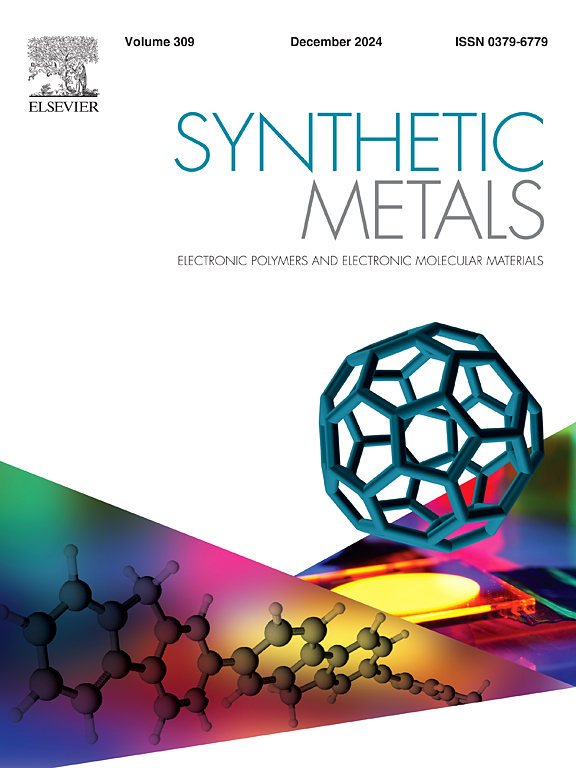Dithieno[3,2-b:2′,3′-d]pyrrole-based hyperbranched conjugated copolymers as efficient fluorescent probes for the trace detection of picric acid
IF 4
3区 材料科学
Q2 MATERIALS SCIENCE, MULTIDISCIPLINARY
引用次数: 0
Abstract
The rapid, selective and trace detection of nitroaromatic compounds is a critical global concern for public security and pollution control due to their potent explosive properties, toxic effects, and significant environmental impact. In this study, we developed a simple and efficient fluorescent sensor using hyperbranched conjugated copolymers (HPCs) containing dithieno[3,2-b:2′,3′-d]pyrrole (DTP) units for the first time to detect picric acid (PA) in all three states: solution, solid, and vapor. Two novel DTP-based HPCs, poly(TPA-alt-DTP) and poly(TPB-alt-DTP), were synthesized through a one-step A2 + B3 direct arylation polycondensation under aerobic conditions of DTP and tribromoaryl monomers such as triphenylamine (TPA) and triphenylbenzene (TPB). These hyperbranched polymers exhibited strong fluorescence and effective PA detection, achieving a very low detection limit of less than 1 μM. Furthermore, they demonstrated excellent selectivity for PA, reaching a fluorescence quenching efficiency of up to 90 % compared to other nitroaromatic interferences. The resulting polymers exhibited superior fluorescent quenching performance due to the hyperbranched structure in the backbone, which provided multi-dimensional transport pathways for excitons to migrate from the electron-rich polymer to the electron-deficient PA through a combination of static quenching and photo-induced electron transfer (PET) mechanisms. In comparison to previous reports, polymer-based fluorescent probes performed exceptionally well in solid and vapor states, sensing PA concentrations as low as 10−15 M using paper tests. The paper sensors proved effective in determining PA in solid, solution, and vapor forms, thereby enhancing their potential for on-site applications.
二噻吩[3,2-b:2 ',3 ' -d]吡咯基超支化共轭共聚物在苦味酸痕量检测中的高效荧光探针研究
硝基芳香族化合物的快速、选择性和痕量检测由于其强大的爆炸特性、毒性作用和重大的环境影响而成为全球公共安全和污染控制的关键问题。在这项研究中,我们首次使用含有二噻吩[3,2-b:2 ',3 ' -d]吡咯(DTP)单元的超支化共轭共聚物(HPCs)开发了一种简单高效的荧光传感器,用于检测三种状态下的苦味酸(PA):溶液、固体和蒸汽。以DTP和三溴芳基单体三苯胺(TPA)和三苯基苯(TPB)为原料,在好氧条件下,通过A2 + B3一步直接芳基化缩聚,合成了两种新型DTP基HPCs,聚(TPA-alt-DTP)和聚(TPB-alt-DTP)。这些超支化聚合物具有很强的荧光性和有效的PA检测,达到了非常低的检测限,小于1 μM。此外,它们对PA具有优异的选择性,与其他硝基芳香族干扰相比,其荧光猝灭效率高达90% %。通过静态猝灭和光诱导电子转移(PET)机制的结合,使激子从富电子聚合物迁移到缺电子的PA提供了多维传输途径,从而使聚合物具有优异的荧光猝灭性能。与之前的报告相比,基于聚合物的荧光探针在固体和蒸汽状态下表现非常好,使用纸质测试可以检测低至10 - 15 M的PA浓度。事实证明,纸张传感器在测定固体、溶液和蒸汽形式的PA方面是有效的,从而提高了它们在现场应用的潜力。
本文章由计算机程序翻译,如有差异,请以英文原文为准。
求助全文
约1分钟内获得全文
求助全文
来源期刊

Synthetic Metals
工程技术-材料科学:综合
CiteScore
8.30
自引率
4.50%
发文量
189
审稿时长
33 days
期刊介绍:
This journal is an international medium for the rapid publication of original research papers, short communications and subject reviews dealing with research on and applications of electronic polymers and electronic molecular materials including novel carbon architectures. These functional materials have the properties of metals, semiconductors or magnets and are distinguishable from elemental and alloy/binary metals, semiconductors and magnets.
 求助内容:
求助内容: 应助结果提醒方式:
应助结果提醒方式:


